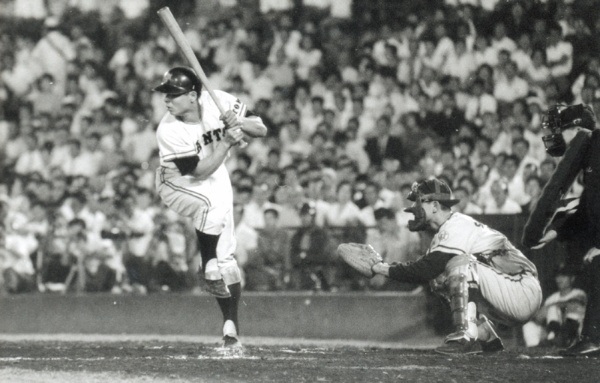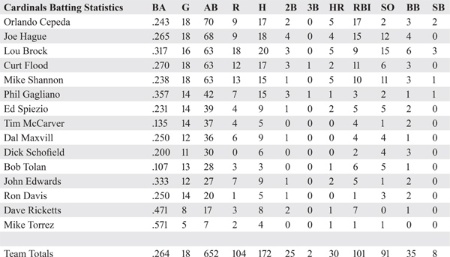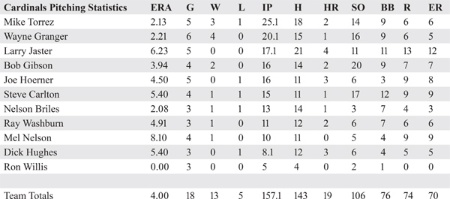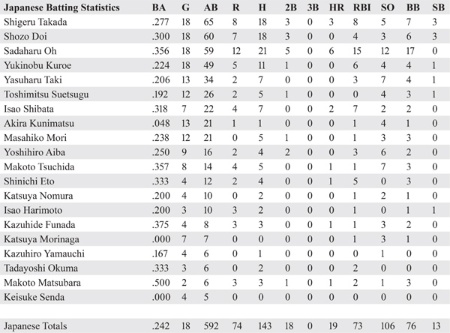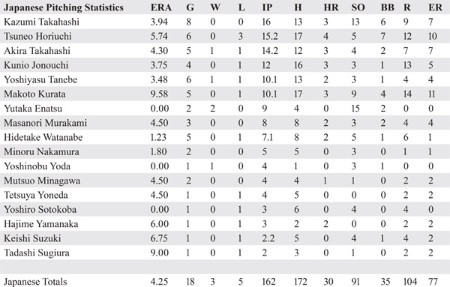Cardinals Take Care of Business in the Land of the Rising Sun (1968)
This article was written by Mark Kanter
This article was published in Nichibei Yakyu: US Tours of Japan, 1960-2019
Japanese star slugger Sadaharu Oh of the Yomiuri Giants. (Robert Fitts Collection)
During 1968, with the United States and much of the world in turmoil, the National League champion St. Louis Cardinals traveled to Japan to play baseball and sightsee. Sponsored by the Yomiuri Shimbun, they played 18 games over 33 days from October 22 to November 24. The Cardinals had participated in a previous goodwill tour to Japan, in 1958, when they won 14 out of 16 games. Since that time, the Japanese had become more competitive against major-league competition, and held the visiting Los Angeles Dodgers to a 9-8-1 record in 1966.
On Tuesday, October 22, a dozen days after the Cardinals lost the World Series to the Detroit Tigers in seven games, they traveled from Los Angeles to Tokyo on a Japan Airlines chartered plane. President Lyndon Baines Johnson promoted the tour by stating that the two countries had more in common than just baseball, but that baseball does bring them together.1
While on the plane during a fog delay at Los Angeles, Cardinals manager Red Schoendienst, Commissioner William D. Eckert, and future Hall of Famer Lou Brock were photographed discussing the 33-day tour. Schoendienst was asked which pitchers he would start in the first few games of the tour. He implied that the two-week layoff after the World Series might hamper the pitchers’ conditioning and that he was still figuring out the rotation.2
Each of the Cardinals players who participated in the series received $3,000 and an additional $750 from the Yomiuri Shimbun. The latter sum was provided in yen, which had to be spent in Japan. The $3,000 would be worth about $23,000 in 2022, and the $750 in yen would be worth about $2,455. The players’ wives were very happy to be included in the trip even if each player had to pay an extra $1,500 to bring them along.3
Before their departure, players Mike Shannon and Tim McCarver said they were interested in doing some hunting while in Japan.4 Bob Gibson, however, was ambivalent about participating in the tour. Immediately after the end of the World Series, he received a vaccination in his arm and was complaining about having to continue pitching after the long season and seven-game World Series. His pitching arm had ached since the second half of the season and he worried that his arm might get damaged with the extra games.
The 1968 expansion draft was held between the World Series and the beginning of the tour. As a result, some of the players participating in the tour were actually no longer on the Cardinals roster. Pitcher Larry Jaster, whom the Cardinals had lost in the draft to the Montreal Expos, was nonetheless asked to go along. The Cardinals also took Bobby Tolan and Wayne Granger to Japan even though they had been traded to the Cincinnati Reds for Vada Pinson. The trade relieved the Cardinals from having to protect both Tolan and Granger in the expansion draft. The Cardinals traded Johnny Edwards to Houston, as well, in preparation for the draft. Edwards also made the trip.
Though they lost the 1968 World Series to the Tigers, the Cardinals had won the Series in 1964 and 1967, and were one of the premier teams in the major leagues. Nevertheless, the Japanese felt that the series between the Cardinals and Yomiuri Giants would be very competitive. An anonymous Giants player suggested that the Cardinals did not seem that formidable. The Giants did seem to have an advantage because the Cardinals had played the tough seven-game World Series but then had a two-week layoff before starting play in Japan.
A sportswriter from the Hochi sports newspaper wrote, “I think Japanese teams can win five, maybe six, in this tour. I saw all 20 American major league teams this summer, and frankly, I was disappointed by American baseball. Many of our techniques are equal or superior – like pitching control, bunting and umpiring accuracy.”5 But, the writer went on to say, “[T]he Japanese game lacks the professional attitude one finds in America. … There is no sense of adventure in our game. An American runner might try to go from first to second base if he thinks he has a chance. A Japanese wouldn’t even consider the possibility. Too much chance of losing face. In a word, what we need is more ‘hassuru’ [hustle].” Daryl Spencer, the former major leaguer then playing in Japan, agreed. “The base running is terrible, and so is the coaching,” he said. He noted that players did not run out groundballs if they felt certain that they were going to be out, and that many Japanese baserunners were thrown out because they kept their heads down not knowing the situation.6
As the games began, the Cardinals started poorly, losing two of the first five. They looked lethargic. Their pitching and hitting were somewhat mediocre, probably due to having just played the seven-game World Series, not practicing much during the two-week layoff, and jet lag. The first three games were played at Korakuen Stadium, in Tokyo, on Friday, October 25; Saturday, October 26; and Sunday, October 27.
The Cardinals beat the Yomiuri Giants by a score of 9-8 in the first game. The Giants, the Japanese champions since 1965, pushed the Cardinals to the limit. Gibson, coming off one of the greatest seasons any pitcher had in the twentieth century, gave up five hits, two walks, and four runs, all earned, in just two innings. He was nursing his arthritic pitching elbow, having taken pills just before the game to dull the pain.7 Wayne Granger, who was no longer in the organization, came on in relief and was the Cardinals’ best pitcher for the game. His line was three innings pitched, one hit, three strikeouts, five bases on balls, and one run, which was earned. Steve Carlton took the mound in the sixth inning. Although Carlton struck out eight batters, he allowed five hits and was wowed by a 420-foot home run that Japanese slugger Sadaharu Oh pulled into the right-field bleachers.
Carlton later credited Oh’s home run and the trip to Japan for the development of his signature slider. He told Steve Wulf of Sports Illustrated in 1994, “I knew how effective Bob Gibson’s slider was but Bob had elbow problems, so I had been looking for a way to throw the slider and minimize the wrist turn that causes elbow injuries. I had been fooling with a pitch, but in Japan, after Sadaharu Oh hit two home runs off me, I figured, what the heck. I threw Oh, a left-handed hitter, the slider. When he backed away and the ball was a strike, I knew I had something.”8 Exactly when this event occurred is unknown as Oh hit only a single home run off Carlton during the tour. In fact, after the opening-game home run, Oh did not get a hit off Carlton.
Neither Gibson nor Carlton was a fan of the low mound at Korakuen Stadium. Nor would Gibson be a fan of the lower mound in the US major leagues for the 1969 season onward.9 Carlton complained that the mound was “almost flat compared to what I’m used to. I couldn’t get behind the ball.”10 After the opening game, manager Schoendienst suggested that Gibson was out of condition after not pitching since the end of the World Series.11 Tetsuharu Kawakami, the Giants’ manager, complained that the Cardinals were out of shape after Gibson was knocked out. Soon enough manager Kawakami would regret his complaint.12
The Giants beat the Cardinals 3-2 in the second game of the series. The Giants were led by outfielder Shigeru Takada, who had two hits and a stolen base. Takada, the 1968 Japan Central League Rookie of the Year, scored the first run of the game in the first inning when he scampered home as Akira Kunimatsu grounded into a double play started by shortstop Dal Maxvill. Giants pitchers Kunio Jonouchi and Yoshiyasu Tanebe held the Cardinals to two runs and five hits. The Giants were able to cobble together enough hits off Briles, Jaster, and Mike Torrez to win the game. Tanebe was the winner. Torrez took the loss when he gave up a game-winning single (today, it would be called a walk-off single) to second baseman Shozo Doi, with one out in the bottom of the ninth. Relief pitcher Tanebe scored the winning run. He made it on base after an unsuccessful sacrifice attempt to move Yasuharu Taki to second base. Tanebe went to second base when Torrez walked Takada. Tolan hit the only home run in the game.13
The Cardinals lost to the Japan All-Stars, 6-0, on October 27, again at Korakuen Stadium. Oh was the batting star of the game when he hit a grand slam in the eighth to put the game away for the All-Stars. Shortstop Kazuhide Funada of the Nishitetsu Lions hit a solo shot in the fifth inning, tallying the first run of the game. Pitchers Joe Hoerner, Mel Nelson, and Dick Hughes of the Cardinals were the victims of the All-Stars’ offensive barrage. Four Japanese pitchers, Mutsuo Minagawa of the Nankai Hawks, Yutaka Enatsu of the Hanshin Tigers, Minoru Murayama of the Tigers, and Fumio Narita of the Tokyo Orions, pitched for the All-Stars. Enatsu struck out seven Cardinals in three innings.14 He became a standout during the tour.
The Japanese didn’t seem overly impressed with the Cardinals early in the tour. Some writers noted that the Giants would be even better once they got back third baseman Shigeo Nagashima (the 1968 Central League MVP) and center fielder Isao Shibata, who were both sidelined with health issues. “[A] Tokyo sportswriter spoke for many when he said: ‘I am disappointed in the Cardinals. There is no show, no excitement about them.’”15
On Tuesday, October 29, at Maruyama Stadium in Sapporo, the Cardinals defeated the Giants, 6-3. Joe Hague, a Cardinal prospect, hit a home run. Carlton and Granger pitched for the Cardinals. Granger was the winner of the game. Tsuneo Horiuchi was the one pitcher who pitched well for the Giants. He gave up one hit in two innings.
After each game, the players and the coaching staff were showered with gifts like electric shavers, happi coats, photo albums, electronic equipment, and yen if they were the winning pitcher, manager, or best player.16 Their entourage was sometimes taken aback when presented with foods such as sushi, raw salmon, jellyfish, bean curd, and rice confections at Japanese restaurants. Sometimes, the players didn’t have a clue as to what they were eating. There were times when they could order up “American” food at their hotels. The Cardinals even met up with a number of interesting items in their dugouts, including charcoal pits and tea kettles.17
The Cardinals met the Giants again on October 30 at Miyagi Prefecture Stadium in Sendai, about 230 miles north of Tokyo. Gibson, who won the game, 8-1, was described as a “speedballer” in the Japan Times. He pitched five innings, giving up one hit, striking out six, and walking one. Jaster gave up three hits and three walks in four innings of mop-up work. Gibson appeared to be over his jet lag and inaction. Brock led off the game with a bunt single. Center fielder Curt Flood followed up with a single that moved Brock to third base with one out. Then catcher Tim McCarver hit a grounder to the pitcher, Kunio Jonouchi, who threw the ball away trying to get Flood at second. Brock scored and the floodgates opened, allowing the Cardinals to score four more runs in the frame when Orlando Cepeda, Hague, Shannon, and Phil Gagliano all followed with singles.
The Cardinals hit a barrage of home runs in the rest of the series. For instance, in the sixth game of the tour, at Osaka Stadium, they beat the combined forces of the Giants and the Nankai Hawks, 7-1. Masanori “Mashi” Murakami started the game and pitched three no-hit innings. Murakami was the first Japanese to pitch in the major leagues. He had pitched for the San Francisco Giants in 1964 and 1965, with good results – 89⅓ innings with a 5-1 record, a 3.43 ERA, and 9 saves. He had a WAR of 1.6 for those two seasons. In 1968, pitching for the Nankai Hawks, he won 18 and lost 4 with an ERA of 2.38 and a WHIP of 1.019. Hague hit a home run for the Cardinals, while Oh hit his third home run of the series. In the 10th game, on November 7 at Toyano Stadium in Niigata, the Cardinals hit four home runs en route to an 8-1 win as Carlton and Torrez combined for a two-hitter. The only run scored by the Giants was on a home run by catcher Makoto Tsuchida. Flood (two home runs), Shannon, and Brock were the long-ball hitters for the Cardinals.18
The Cardinals became a buzzsaw from games 9 through 18 – whether they were facing the Giants, an all-star team, a combined Giants/Nishitetsu Lions team, a combined Giants/Chunichi Dragons team, or a combined Giants/Hiroshima Toyo Carp team. The Cardinals won eight and lost two games. They hit a total of 23 home runs in those 10 games and scored 69 runs to 48 by the Japanese.
On November 8, a day off from games, some of the Cardinals players including, Brock, Cepeda, Ray Washburn, and Gibson, and coach Dick Sisler visited with Vietnam war wounded at various US military hospitals in Japan. Brock visited and signed autographs for wounded at the US Army Hospital at Camp Zama. Gibson, Cepeda, Washburn, and Sisler visited with the servicemen at Kishine Hospital while others visited Camp Oji and Camp Drake The servicemen discussed pitching with Washburn. Some Marines explained to the players that they were celebrating the anniversary of the start of the Marines. Gibson started to ask the other players and Sisler when and where the Marines had been formed. Sisler provided the date of 1775 and Washburn and Cepeda provided Philadelphia as the location. Gibson added that the Marines were started in a bar in that colonial city. Gibson suggested that his arm was hurting during the visit. After that, one of the Marines asked Gibson how his leg was feeling after being broken by a batted ball hit by Roberto Clemente in 1967. He said it was feeling good until he was asked about it.19
On Saturday, November 16, ABC’s Wide World of Sports televised the taped-delayed November 9 game against the Japan All-Stars at Tokyo Stadium. Gibson pitched five innings, struck out seven batters, walked six, and gave up three runs, all earned. He contributed offensively, too, with a single, a double, and a steal of second base. Gibson even struck out Oh twice. He did give up a three-run homer to Shinichi Eto in the first inning. Catcher Katsuya Nomura, who was the next batter, was the all-time Japan leader in career home runs at that point. Gibson got Nomura to fly out to right field.20
The Cardinals beat a combined Giants-Carp team in Hiroshima, 5-3, on November 12. Torrez pitched a complete-game seven hitter. Yoshiro Sotokoba of the Carp, who won the Central League ERA title, pitched three innings, giving up six hits, four walks, and four runs, all unearned. After the game, the Cardinals and their entourage went on a sightseeing trip to the Hiroshima Peace Memorial Park. While many of the players were too young to remember the 1945 bombings, they quickly understood the devastation that that holocaust created. Commissioner Eckert (a former Air Force lieutenant general), Schoendienst, and Musial laid wreaths at the memorial.21
In Nagoya, at Nagoya Stadium, on November 19, the Cardinals defeated a combination of Yomiuri Giants and Chunichi Dragons, 3-2. Torrez and Brock hit home runs. Torrez is forever remembered by legions of baseball fans for giving up Bucky Dent’s home run in the 163rd and final tiebreaker game of the 1978 AL East regular season, which propelled the Yankees into the ALCS. The Japanese team did score once in the fourth inning off Torrez.
Every once in a while the Japanese team would come up with a pitching gem to defeat the Cardinals. The 16th game of the tour showcased Akira Takahashi, who pitched a two-hit shutout for the Giants. Brock and McCarver got the only hits in the game for the Cardinals. Takahashi didn’t record a strikeout.22 He had had an up-and down career until 1968. He became the Giants’ third starter from 1963 through 1965 with middling results. In 1963 he won 14 and lost 13 with a 2.80 ERA, which was third best for the Giants rotation. After 1965 he was moved to the bullpen. However, he had a renaissance year in 1968 when he became a part-time starter. He won nine and lost eight for the Giants in 1968 with an ERA of 2.90 and a WHIP of 1.026. Interestingly, he pitched only seven shutouts in his career: three in 1963, two in 1965, and two in 1971.
The final game of the tour encapsulated the dominance of the Cardinals hitters over the Japanese. The game was played in Shizuoka, about 90 miles southwest of Tokyo, on November 20. Exactly 34 years earlier, on November 20, 1934, in the same ballpark, Eiji Sawamura held Babe Ruth’s All-Americans to just one run as he fanned Charlie Gehringer, Ruth, Lou Gehrig and Jimmie Foxx in succession. Although Sawamura lost the game, 1-0, the outing had made him a national hero. But the 1968 game was different. The Cardinals won, 16-9, with 14 hits compared with the Giants’ 12. The Cardinals hit seven home runs – two by Cepeda, two by Ed Spiezio, and one each by Hague (a grand slam), Brock and Shannon. The Giants hit four home runs with Shigeru Takada and Isao Shibata hitting one apiece and Oh hitting his final two homers of the series. Jaster and Granger were the Cardinals pitchers. Granger ended up with the win.23
At the end of the final game, each of the Cardinals players gave a bat to a Giants player. They swapped caps and said sayonara. This may have been when Oh gave Brock one of his compressed bats. Oh had been using this kind of bat since the 1964 season. He started to use a hand-made bat made by Jun Ishii. Ishii was looking for a harder wood and started to make his bats using the wood from a male yachidamo tree. The water and air had to be removed from the wood to ensure that it was as hard as possible. The sound of the bat hitting the ball provided Oh with a sound like no other.24 Bowie Kuhn, who became commissioner in 1969, barred Brock from using the compressed bat. In Japan the use of a compressed bat was disallowed after Oh retired in 1980. The bat was thought to give an advantage to the hitter because the wood is condensed. However, the research is not definitive.25
Despite the Japanese media’s pre-tour belief that their countrymen would challenge the Cardinals, the Japanese did not fare as well as they had anticipated. St. Louis won the series, 13 games to 5. The Giants, winners of four consecutive Japanese titles on their way to nine in a row, as well as the Japanese all-star teams, were thoroughly dominated by the Cardinals’ hitting – even though they were not considered a great hitting team during the 1968 National League campaign.
The Cardinals, who hit 73 home runs in the 162-game regular season, hit 30 in the 18-game series. Mike Shannon suggested that the Cardinals would hit 300 home runs in a season playing in the smaller parks and against Japanese pitching.26 Up-and-coming young pitcher Torrez, who won three and lost one on the tour, hit .571. He stated that the Japanese hitters would choke up after two strikes. They didn’t go for the long ball, except perhaps for Oh. His opinion was that US major-league hitters were more often looking for the long ball.27
Oh led all of the players with six home runs. He had hit 58 in the Japanese regular season. Brock, Cepeda, and Shannon each hit five home runs and Hague pitched in with four. Oh had the most hits, 21 (he hit .356). Brock had 20 hits. Cepeda led the tour with 17 RBIs; Oh and Hague were tied with 15. Granger had four wins along with a 2.21 ERA. Torrez had a 2.13 ERA and three wins. Gibson had 20 strikeouts, followed by Carlton with 17, Granger with 16, and Hanshin’s Yutaka Enatsu with 15. Enatsu pitched great against the Cardinals. He won two games while giving up only four hits and striking out 15 in nine innings, and had a 0.00 ERA. Gibson and Carlton were relatively mediocre on the tour. Gibson won two games while posting a 3.94 ERA in 16 innings. Carlton, who won one game, had a 5.40 ERA in 15 innings.
At the end of the tour, the Cardinals entourage felt that Oh and Enatsu were ready to play in the US major leagues. Schoendienst was effusive in his praise for both players and suggested that Enatsu was one of the best left-handed pitchers he had ever seen. He noted that Oh probably wouldn’t come to the United States because of salary demands. Oh made about $97,000 and Enatsu made about $50,000. Both had lucrative product endorsement contracts as well.28
The major leagues have had a number of Japanese players who have done very well since 1968. They players include Hideo Nomo, Hideki Matsui, Ichiro Suzuki, Daisuke Matsuzaka, and Shohei Ohtani. Moreover, Japanese ballplayers won the first two World Baseball Classics, in 2006 and 2009.29 However, in 1968, the Cardinals were the Kings in Japan. Interestingly, the Cardinals had to wait another 14 years to win a pennant and participate in a World Series.
MARK KANTER grew up in Bristol, Pennsylvania, where he became a lifelong Philadelphia Phillies fan. He got the itch watching the last few outs of Jim Bunning’s perfect game against the Mets on Father’s Day in 1964. As a member of SABR since 1985, he has made numerous presentations at SABR meetings and conventions, as well as writing several articles for the Baseball Research Journal, the Northern Game and Beyond, and the National Pastime 43: From Swampoodle to South Philly, and several SABR BioProject biographies. He was the editor of the Northern Game and Beyond, the 2002 Boston SABR Convention publication. He has won 12 SABR team trivia contests since 1997, inclusive. He and his wife, Lynne, who is a great baseball fan in her own right, have discussed and watched baseball in Cuba, Puerto Rico, Great Britain, Australia, Japan, Canada, and the United States. Since retirement after 31 years as an engineer for the US Navy, he has been preparing taxes for AARP Tax Aide and playing Stratomatic365 baseball online. He and Lynne live in the idyllic seaside community of Portsmouth, Rhode Island, where he is on the town’s canvassing board.
Acknowledgments
I’d like to thank Robert Whiting for providing personal information about Oh’s compressed bat and manager Kawakami’s take on the Cardinals after the first few games of the tour; Robert Fitts for providing encouragement and many Japan Times and Pacific Stars and Stripes articles about the tour; Kanya Honoki of Nara, Japan, who provided a concise translation of the Japanese magazine Japan x USA Baseball Game History, Baseball Game Magazine, Inc. 2004. I’d like to acknowledge my wife, Lynne Glickman, for reading and providing insight and editing of the article. Finally, I appreciate SABR for asking me to write this article.
(Click images to enlarge)
Notes
1 United Press International, “LBJ Boosts Tour,” Pacific Stars and Stripes (Tokyo), October 24, 1968: 22.
2 Lee Kavetski, “Cardinals Wing in for Japan Tour,” Pacific Stars and Stripes, October 25, 1968: 17, 20.
3 Jack McGrath, “A Bit of This and a Bit of That,” Troy (New York) Times Record, December 7, 1968: 14. Brock’s wife made enough purchases to expand their beginning total of five suitcases to 14 suitcases by the end of the trip. This led to some issues at the St. Louis airport on the return trip, when he was reunited with his trunk and five boxes after they were misplaced. Many of the wives purchased pearls. Backup infielder Ducky Schofield, who was known as a clothes maven, ended up with 26 suitcases of tailor-made clothes and electronics. Brock recounted that Nelson Briles, Bob Gibson, and Mike Shannon bought their fair share of Nikon cameras. Orlando Cepeda bought electronics. “Weary Cards Back Home,” Pacific Stars and Stripes, November 27, 1968: 19.
4 Associated Press, “Cards Ready to Leave, Pacific Stars and Stripes, October 23, 1968: 22.
5 Mike Berger, “The Foreign Flavor in Japanese Baseball,” Pacific Stars and Stripes, October 28, 1968: 9.
6 Berger, “The Foreign Flavor in Japanese Baseball.”
7 Kent Nixon, “Viet Vets Wow Cardinal Stars,” Pacific Stars and Stripes, November 10, 1968: 17, 19.
8 Steve Wulf, “Steve Carlton,” Sports Illustrated, January 24, 1994: 48.
9 Mike Berger, “Cards Look So-So to Japanese Fans,” The Sporting News, November 23, 1969: 45. The mound height in the major leagues was 15 inches through 1968. The two leagues had decided to lower it to 10 inches because hitting had become so abysmal. The major-league batting average was .237 in 1968 with Carl Yastrzemski leading the American League with a .301 batting average. This was and still is the lowest batting average to lead a major league. Moreover, Gibson, who had a 1.12 ERA, set the standard for the lowest ERA ever for a qualified pitcher. A qualified pitcher must throw at least one inning per game for his team. In most seasons that is 162 innings based upon a 162-game season. Denny McLain won 31 games for the Tigers. Both are standards that haven’t been matched in 53 seasons (1969 through 2021).
10 Kent Nixon, “Oh Makes a Hit with Carlton,” Pacific Stars and Stripes, October 27, 1968: 16.
11 Nixon, “Oh Makes a Hit with Carlton”; “Cardinals Beat Tokyo Giants in Opener,” Chillicothe (Missouri) Constitution-Tribune, October 25, 1968: 11. See also “Cardinals Edge Giants in Opener,” Japan Times, October 26, 1968: 7.
12 Robert Whiting (personal communication, October 6, 2021).
13 “Giants Upset Cards with 3-2 Victory,” Japan Times, October 27, 1968; “Tokyo Giants Even Series with Cards,” Jefferson City (Missouri) Sunday News and Tribune, October 27, 1968: 14.
14 “Japanese All-Stars Clobber Cards 6-0,” Japan Times, October 28, 1968: 7.
15 Berger, “Cards Look So-So to Japanese Fans.”
16 “Japan Land of Fun for Gift-Laden Cards,” The Sporting News, December 14, 1968: 29.
17 Gordon Newell, “Morin Ranked 14th Among NFL Receivers,” Fitchburg (Massachusetts) Sentinel, November 20, 1968: 8.
18 “Cards’ 4 HRs Win 8-1,” Pacific Stars and Stripes, November 9, 1968: 18.
19 Nixon, “Viet Vets Wow Cardinal Stars,” 19.
20 Lee Kavetski, “Cards Smack Down All-Stars 13-10,” Pacific Stars and Stripes, November 11, 1968: 20; Kent Nixon, “Name it – Big Bob Does it,” Pacific Stars and Stripes, November 11, 1968: 20.
21 “Japan Land of Fun for Gift-Laden Cards.” The author can imagine what the entourage’s thoughts were when visiting the Peace Park. He had been there in 2018 with his wife. It is so hauntingly devastating and moving just thinking about a situation where people just vanish in minutes. Personal reflection.
22 “2-Hitter Blanks Cards,” Pacific Stars and Stripes, November 19, 1968: 20.
23 “Cards End Series with 16-9 Deluge,” Pacific Stars and Stripes, November 22, 1968: 20.
24 Sadaharu Oh and David Falkner, Sadaharu Oh: A Zen Way of Baseball (Tokyo: Kodansha, 1984), 181-83.
25 Robert Whiting (personal communication, October 6, 2021).
26 “Shannon Liked Japan Parks,” Pacific Stars and Stripes, November 29, 1968: 19.
27 Kent Nixon, “Happy Days for Torrez,” Pacific Stars and Stripes, November 24, 1968: 18.
28 Red Schoendienst, “Red Looks at Cards and adds up ’69 Chances,” Pacific Stars and Stripes, November 14, 1968: 19.
29 https://www.mlb.com/world-baseball-classic.
30 Listed Japanese players have a minimum of 5 at-bats, 3 innings pitched, or a decision. Yoshikazu Matsubayashi, Baseball Game History: Japan vs, U.S.A. (Tokyo: Baseball Magazine, 2004), 97; Nippon Professional Baseball Records, https://www.2689web.com/nb.html.


